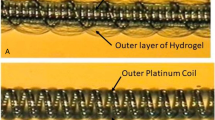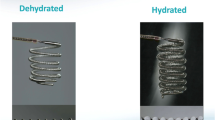Abstract
Background
HydroSoft (MicroVention, Aliso Viejo, CA), a hydrogel-platinum coil hybrid device, is one of various efforts to overcome recanalization of coiled intracranial aneurysms. The purpose of this study was to evaluate the efficacy and safety of the HydroSoft coils in patients with intracranial aneurysms, and to compare the 12-month outcomes with that of bare platinum coils.
Methods
Four-hundred one patients harboring 430 intracranial aneurysms underwent endovascular embolization with the HydroSoft coils. In the control group, 221 patients harboring 253 aneurysms underwent coil embolization with bare platinum coils. The authors compared the degree of occlusion of the aneurysms, packing attenuations, procedural-related complications, and 12-month follow-up results between the two groups.
Results
There were no significant differences of initial angiographic outcomes and procedure-related complications between the HydroSoft-coil group and the bare-coil group. Mean volumetric packing density of the HydroSoft-coil group was significantly higher than that of the bare platinum coil group (36.0 ± 8.50 % versus 32.1 ± 8.22 %, p < 0.001). The retreatment was performed in four (1.8 %) of 225 followed-up aneurysms among the HydroSoft coil group and 20 (8.8 %) of 227 followed-up aneurysms among the bare platinum coil group (p = 0.001, Fischer’s exact test). Multivariate Poisson regression revealed that coil embolization using the HydroSoft coil significantly reduces the retreatment rate of coiled aneurysms at 12-month follow-up (adjusted RR, 0.21; 95 % CI, 0.07-0.64; p = 0.004).
Conclusion
Coil embolization using HydroSoft coils achieves higher volumetric packing density. Twelve-month follow-up data favors HydroSoft coils, with lower retreatment rates.


Similar content being viewed by others
References
Brilstra EH, Rinkel GJ, van der Graaf Y, van Rooij WJ, Algra A (1999) Treatment of intracranial aneurysms by embolization with coils: a systematic review. Stroke 30:470–476
Cloft HJ (2007) HydroCoil for endovascular aneurysm occlusion (HEAL) study: 3–6 month angiographic follow-up results. AJNR Am J Neuroradiol 28:152–154
Cloft HJ, Kallmes DF (2004) Aneurysm packing with HydroCoil embolic system versus platinum coils: initial clinical experience. AJNR Am J Neuroradiol 25:60–62
Ferns SP, Sprengers ME, van Rooij WJ, Rinkel GJ, van Rijn JC, Bipat S, Sluzewski M, Majoie CB (2009) Coiling of intracranial aneurysms: a systematic review on initial occlusion and reopening and retreatment rates. Stroke 40:e523–e529
Guo XB, Fan YM, Zhang JN (2010) HydroSoft coil versus HydroCoil for endovascular aneurysm occlusion study: a single center experience. Eur J Radiol 79:e42–e46
Im SH, Han MH, Kwon BJ, Jung C, Kim JE, Han DH (2007) Aseptic meningitis after embolization of cerebral aneurysms using hydrogel-coated coils: report of three cases. AJNR Am J Neuroradiol 28:511–512
Jennett B, Snoek J, Bond MR, Brooks N (1981) Disability after severe head injury: observations on the use of the Glasgow outcome scale. J Neurol Neurosurg Psychiatry 44:285–293
Kang HS, Han MH, Kwon BJ, Jung C, Kim JE, Kwon OK, Oh CW (2010) Is clopidogrel premedication useful to reduce thromboembolic events during coil embolization for unruptured intracranial aneurysms? Neurosurgery 67:1371–1376, discussion 1376
Kang HS, Han MH, Kwon BJ, Jung SI, Oh CW, Han DH, Chang KH (2004) Postoperative 3D angiography in intracranial aneurysms. AJNR Am J Neuroradiol 25:1463–1469
Kang HS, Han MH, Lee TH, Shin YS, Roh HG, Kwon OK, Kwon BJ, Kim SY, Kim SH, Byun HS (2007) Embolization of intracranial aneurysms with hydrogel-coated coils: result of a Korean multicenter trial. Neurosurgery 61:51–58, discussion 58–59
Kawanabe Y, Sadato A, Taki W, Hashimoto N (2001) Endovascular occlusion of intracranial aneurysms with Guglielmi detachable coils: correlation between coil packing density and coil compaction. Acta Neurochir (Wien) 143:451–455
Killer M, Hauser T, Wenger A, Richling B, Ladurner G (2009) Comparison of experimental aneurysms embolized with second-generation embolic devices and platinum coils. Acta Neurochir (Wien) 151:497–505, discussion 505
Killer M, Kallmes D, Jones R, Ding Y, Vestal M, Hauser T, Virmani R, Cruise G Long-term angiographic and histological results of a new hydrogel-containing filling coil in experimental rabbit aneurysms. Minim Invasive Neurosurg 53:97–105
Kwon BJ, Han MH, Oh CW, Kim KH, Chang KH (2002) Anatomical and clinical outcomes after endovascular treatment for unruptured cerebral aneurysms. A single-center experience. Interv Neuroradiol 8:367–376
Molyneux AJ, Kerr RS, Yu LM, Clarke M, Sneade M, Yarnold JA, Sandercock P (2005) International subarachnoid aneurysm trial (ISAT) of neurosurgical clipping versus endovascular coiling in 2143 patients with ruptured intracranial aneurysms: a randomised comparison of effects on survival, dependency, seizures, rebleeding, subgroups, and aneurysm occlusion. Lancet 366:809–817
Park JH, Kang HS, Han MH, Jeon P, Yoo DS, Lee TH (2011) Embolization of Intracranial Aneurysms with HydroSoft Coils: Results of the Korean Multicenter Study. AJNR Am J Neuroradiol
Roy D, Milot G, Raymond J (2001) Endovascular treatment of unruptured aneurysms. Stroke 32:1998–2004
Sluzewski M, van Rooij WJ, Slob MJ, Bescos JO, Slump CH, Wijnalda D (2004) Relation between aneurysm volume, packing, and compaction in 145 cerebral aneurysms treated with coils. Radiology 231:653–658
Tamatani S, Ito Y, Abe H, Koike T, Takeuchi S, Tanaka R (2002) Evaluation of the stability of aneurysms after embolization using detachable coils: correlation between stability of aneurysms and embolized volume of aneurysms. AJNR Am J Neuroradiol 23:762–767
Tsumoto T, Niimi Y, Berenstein A (2009) Evaluation of the new HydroSoft coil in a canine model of bifurcation aneurysm. Laboratory investigation. J Neurosurg 111:11–16
White PM, Lewis SC, Gholkar A, Sellar RJ, Nahser H, Cognard C, Forrester L, Wardlaw JM (2011) Hydrogel-coated coils versus bare platinum coils for the endovascular treatment of intracranial aneurysms (HELPS): a randomised controlled trial. Lancet 377:1655–1662
Conflict of interest
MHH consults for Microvention, and a consultant fee has been paid to his institution.
Author information
Authors and Affiliations
Corresponding author
Rights and permissions
About this article
Cite this article
Lee, J.Y., Seo, J.H., Lee, S.J. et al. Mid-term outcome of intracranial aneurysms treated with HydroSoft coils compared to historical controls treated with bare platinum coils: a single-center experience. Acta Neurochir 156, 1687–1694 (2014). https://doi.org/10.1007/s00701-014-2157-y
Received:
Accepted:
Published:
Issue Date:
DOI: https://doi.org/10.1007/s00701-014-2157-y




